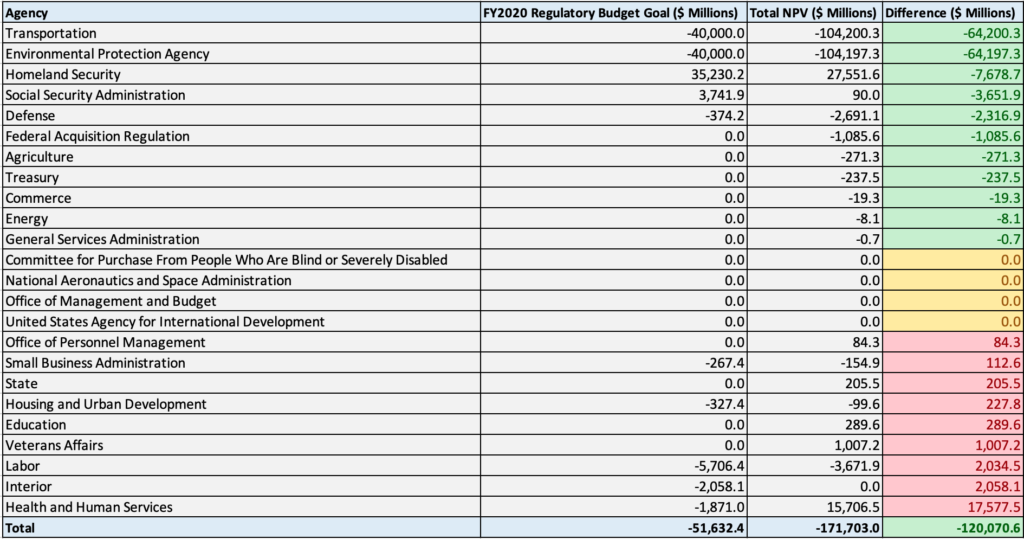Research
September 30, 2020
Projecting FY 2020 Regulatory Budget Results
EXECUTIVE SUMMARY
- A review of the 179 federal rules subject to the regulatory budget that were finalized between October 1, 2019, and September 30, 2020, shows that covered agencies have saved an estimated net present value of $171.7 billion.
- The totality of the savings comes from the Safer, Affordable Fuel-Efficient Vehicles rule, which has an estimated savings of $199.5 billion.
- The agencies with the most savings finalized, by a wide margin, are the Environmental Protection Agency and the Department of Transportation, while the agencies with the most costs finalized are the Department of Homeland Security and the Department of Health and Human Services.
- A number of expensive regulations that would have significantly cut into the administration’s savings total were exempted from the regulatory budget total due to national security exemptions and the COVID-19 health emergency.
INTRODUCTION
With the regulatory budget year concluding on September 30, this analysis projects the Trump Administration’s final tally ahead of its official accounting later this year. The projection finds that the administration achieved its highest total of net present value (NPV) savings yet, and more than doubled its regulatory budget savings goal.
Despite these successes, the total savings come entirely from one enormous deregulatory action. Absent that rule, the administration would have added nearly $30 billion in economic costs from actions subject to the regulatory budget in fiscal year (FY) 2020.
There were also several rules with sizable costs that the agency finalizing the rule marked as exempt from the regulatory budget due to national security implications and the COVID-19 health emergency.
HOW THE REGULATORY BUDGET WORKS
The regulatory budget was established under Executive Order (EO) 13,771, one of the first executive orders issued by President Trump in January 2017. Under that EO, the White House’s Office of Information and Regulatory Affairs established an administration-wide target for FY 2020 of $51.6 billion in NPV savings from new rules, with each covered agency receiving a prescribed target.
Not all rules count under EO 13,771 – in fact, most do not. The EO, and its subsequent guidance, define an “EO 13,771 regulatory action” as one that has an annual effect on the economy of $100 million or more; creates a serious inconsistency or otherwise interferes with an action taken or planned by another agency; materially alters the budgetary impact of entitlements, grants, user fees, or loan programs; or raises novel legal or policy issues and is finalized with costs greater than zero. An EO 13,771 deregulatory action, however, is merely an action finalized with costs less than zero.
To hold agencies accountable to meet their targets, EO 13,771 requires that any covered agency failing to meet its target must develop a written plan explaining how it intends to make up for the excess costs in the future. EO 13,771 does not impose any penalty beyond that, however, and none of these plans that should have been developed from previous years have been made public – so there may not be any penalty at all.
ADMINISTRATION-WIDE RESULTS
The Trump Administration established a target of $51.6 billion in net present value savings for FY 2020. The value of actions is derived from using the agency’s own estimate of its action. The American Action Forum (AAF) analyzed 179 final rules identified by the issuing agency as counting under EO 13,771 and the regulatory budget. The cumulative NPV of these actions is $171.7 billion in savings, a surplus of more than $120 billion over the budget goal. That total more than triples the cumulative NPV of the first three years of Trump Administration regulatory budgets, which the administration pegs at $50.9 billion.
What appears to be a systemic achievement in finalizing deregulatory measures with considerable economic savings is actually the result of one extraordinary rule. That rule is the Safer Affordable Fuel-Efficient (SAFE) Vehicles rule, the NPV of which is split between the Environmental Protection Agency (EPA) and the Department of Transportation (DOT); the rule banks estimated NPV savings of $199.5 billion.
Including the SAFE Vehicles rule, the Trump Administration finalized 133 deregulatory actions with a total NPV savings estimate of $222.3 billion, against 46 regulatory actions with a total NPV costs estimate of $50.6 billion. Remove the SAFE Vehicles rule and the administration would have imposed $27.8 billion in NPV costs through its FY 2020 final rules subject to the regulatory budget.
The number of deregulatory actions exceeds regulatory actions by a ratio of nearly 3-to-1, exceeding the 2-to-1 ratio established as policy in EO 13,771. That ratio shrinks, however, when comparing actions with estimated economic impact. Removing actions with no quantified estimate results in a ratio of just under 2-to-1 (73 deregulatory and 38 regulatory).
AGENCY-BY-AGENCY RESULTS
AAF projects 11 agencies stay under their budget cap, with four additional agencies hitting zero net impact. The table below shows how agencies fared against their budget cap.[1]
Totals may not sum due to rounding.
Of note, only three agencies that stayed under their cost cap were budgeted for net savings in FY 2020. The remaining either imposed fewer costs than expected or accrued savings when their target was zero net impact. Of the eight agencies expected to achieve net savings in FY 2020, all but the Departments of the Interior and Health and Human Services (HHS) did so.
DOT and EPA led the way with more than $100 billion in NPV savings each, with DOT narrowly edging out EPA for the most savings. Aside from the SAFE Vehicles rule, other rules contributing to DOT’s savings were a rule easing the Hours of Service regulations for commercial truck drivers ($3.1 billion) and a measure streamlining driver reports for buses and other passenger carrying vehicles ($771.4 million).
EPA’s biggest savings contributions came from deregulatory actions that it split with other agencies. In addition to the SAFE Vehicles rule it issued jointly with DOT, its next biggest savings came from two rules for which it partnered with the Department of Defense (DOD) revising the definition of Waters of the United States (which combined totaled $2.3 billion, its share of a $4.6 billion split).
The Department of Labor came in with the third-most savings despite coming up $2 billion short of its budget target. It reaped about $4.6 billion in savings from a rule that allows employers to switch the default method of providing benefit plan disclosures from paper to electronic means.
On the other side of the ledger, the Department of Homeland Security (DHS) issued the most costs. Its two notable regulatory actions were both related to tightening immigration. The first made changes to the asylum process with the intent of bringing greater scrutiny on an asylum-seeker’s application ($24 billion), and the second removed a time limit for DHS to act on employment authorization requests ($3.6 billion).
In a surprise reversal, HHS, which led all agencies in NPV savings in FYs 2018 and 2019, published the second-most costs with $15.7 billion, including five rules with more than $1 billion in costs. Its costliest rule established a framework to encourage interoperability in health information technology but came with a price tag of $12 billion. Rounding out the top three costliest agencies is the Department of Veterans Affairs, which issued an NPV of $1 billion in costs, primarily through one rule.
NOTABLE “OFF-BUDGET” REGULATIONS
The regulatory budget – as established by EO 13,771 – continues to be a relatively new work-in-progress. One underappreciated aspect of it is the series of exemptions it provides. According to the guidance set forth by the White House’s Office of Management and Budget, agencies can exempt rules from EO 13,771 consideration for the following reasons: “1) expressly exempt actions [due to national security or foreign affairs issues]; 2) emergency actions; 3) statutorily or judicially required actions; and 4) de minimis actions.” Given the unique developments of this past year, there is a series of notable rules that, while likely avoiding inclusion in the administration’s official FY 2020 accounting for the aforementioned reasons, bring economic impacts worth examining.
The first of these is actually the costliest final rule published over the past year across any agency. Per AAF tracking on regrodeo.com, this rule is the second costliest on record going back to 2005. This “Federal Acquisition Regulation” (FAR) – promulgated jointly by DOD, General Services Administration, and National Aeronautics and Space Administration – was published in the Federal Register on the penultimate day of the fiscal year. The rule seeks “to implement a DOD Assessment Methodology and Cybersecurity Maturity Model Certification framework in order to assess contractor implementation of cybersecurity requirements and enhance the protection of unclassified information within the DOD supply chain.” The FAR agencies estimate that the rulemaking’s requirements could impose roughly $92.8 billion in total costs on the public. This figure does not apply to EO 13,771 calculations, however, “because this rule is being issued with respect to a national security function of the United States.”
The second most consequential “off-budget” rule is another national security-related FAR. This one prohibits federal contractors from utilizing technology from Huawei Technologies or ZTE Corporation due to concerns of China’s potential to compromise such systems and requires said contractors to certify that they are not using such technologies. The agencies estimate that this certification process brings nearly $43 billion in total costs given the broad scope of entities affected. It claims exemption from EO 13,771 consideration, however, since it “is anticipated to improve national security as its primary direct benefit.”
The other notable “off-budget” regulations are, unsurprisingly, tied to the ongoing response to COVID-19. These rules generally fall into the buckets of a) emergency actions and/or b) directly implementing legislation passed in response to the public health crisis – both of which are EO 13,771 exemptions. The most significant of these rules include:
- “Medicare and Medicaid Programs, Clinical Laboratory Improvement Amendments (CLIA), and Patient Protection and Affordable Care Act; Additional Policy and Regulatory Revisions in Response to the COVID-19 Public Health Emergency” ($4.5 billion in costs)
- “Paid Leave Under the Families First Coronavirus Response Act” ($553.2 million in costs)
- “Medicare and Medicaid Programs; Policy and Regulatory Revisions in Response to the COVID-19 Public Health Emergency” ($153.2 million in cost savings)
Taken together, these five “off-budget” rules represent roughly $140.6 billion in net costs. If one were to include these costs in the FY 2020 tally, the total net savings would only be $31.1 billion – or roughly $20.5 billion short of the administration’s overall goal. While it may be justifiable to delineate between these actions and more typical rulemakings given the national interests involved, it is still important to consider the broader economic impact.
CONCLUSION
Based on agency estimates of economic impact among rules published in the Federal Register, the Trump Administration is projected to achieve regulatory budget savings of $171.7 billion for FY 2020. This total stems entirely from the large savings from the extraordinary SAFE Vehicles rule. Absent that rule, the administration would have added nearly $30 billion in economic costs from actions subject to the regulatory budget.
Because of atypical situations arising from national security concerns and actions addressing the COVID-19 health emergency, several significant rules were exempted from the regulatory budget projection. The total NPV of these rules is $140.6 billion in costs. If these rules were included in the projection, the Trump Administration would have been about $20 billion short of achieving its target of $51.6 billion in savings.
[1] An expanded version breaking down NPV by each agency’s cumulative regulatory and deregulatory actions can be accessed here.












